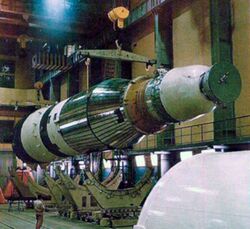Astronomy:Cosmos 154
Cosmos 154 (or Космос 154 in Russian) was a Soviet test spacecraft launched from the Baikonur Cosmodrome aboard a Proton-K rocket. It was a Prototype Soyuz 7K-L1P launched by Proton and failed to go into planned translunar trajectory. It was also a probable manned precursor to the Zond series. It reached Earth orbit but the Block D translunar injection stage failed to fire (ullage rockets, which had to fire to settle propellants in tanks before main engine fired, were jettisoned prematurely). The spacecraft burned up two days later when orbit decayed.[1][2]
History
Two test flights of the UR-500K/L1 system were performed in March and April 1967 under the designations Kosmos 146 and Kosmos 154. In April 1967, under the cover name Kosmos-154, the third model of the L-1 was placed into near-Earth orbit. Because of a control system failure that resulted in the premature jettisoning of the ullage motors, the main propulsion system of the Block-D did not ignite.[3]
Cosmos 154 was one of the first Zond attempts. It was supposed to flyby the Moon but Achieved Earth orbit only. After spending two days in Earth Orbit, it reentered Earth's Atmosphere and burned up during Reentry.[4]
Launch Information
Launch Date: 1967-04-08 at 09:07:00 UTC
Launch Vehicle: Proton-K
Launch Site: Tyuratam (Baikonur Cosmodrome), U.S.S.R
Decay Date: 1967-04-10
Trajectory Details
| Type: Orbiter | ||||
| Central Body: Earth | ||||
| Epoch start: 1967-04-08 04:07:00 UTC | ||||
| Orbital Parameters | ||||
| Periapsis | Apoapsis | Period | Inclination | Eccentricity |
| 183 km | 223 km | 88.5 minutes | 51.6° | 0.00304 |
Gallery
A close up image of the Moon taken by Zond 8 in 1970.
A stamp from the Soviet Union in 1969 Illustrating the September, 1968 Zond 5 Spacecraft Lunar Flyby.
References
- ↑ Grayzeck, Edward (August 17, 2014 - March 9, 2016). "NASA - NSSDCA - Spacecraft - Trajectory Details". https://nssdc.gsfc.nasa.gov/nmc/spacecraft/display.action?id=1967-032A.
- ↑ "NASA - NSSDCA - Spacecraft - Details". https://nssdc.gsfc.nasa.gov/nmc/spacecraft/display.action?id=1967-032A.
- ↑ Grahn, Sven (August 29, 2002 - October 25, 2017). "Kosmos 146 and Kosmos 154". http://www.svengrahn.pp.se/histind/Cosmos146/Cosmos146.htm.
- ↑ Braeunig, Robert (May 15, 2004 - November 3, 2017). "Lunar Spacecraft (Unmanned)". http://www.braeunig.us/space/lunar.htm.







